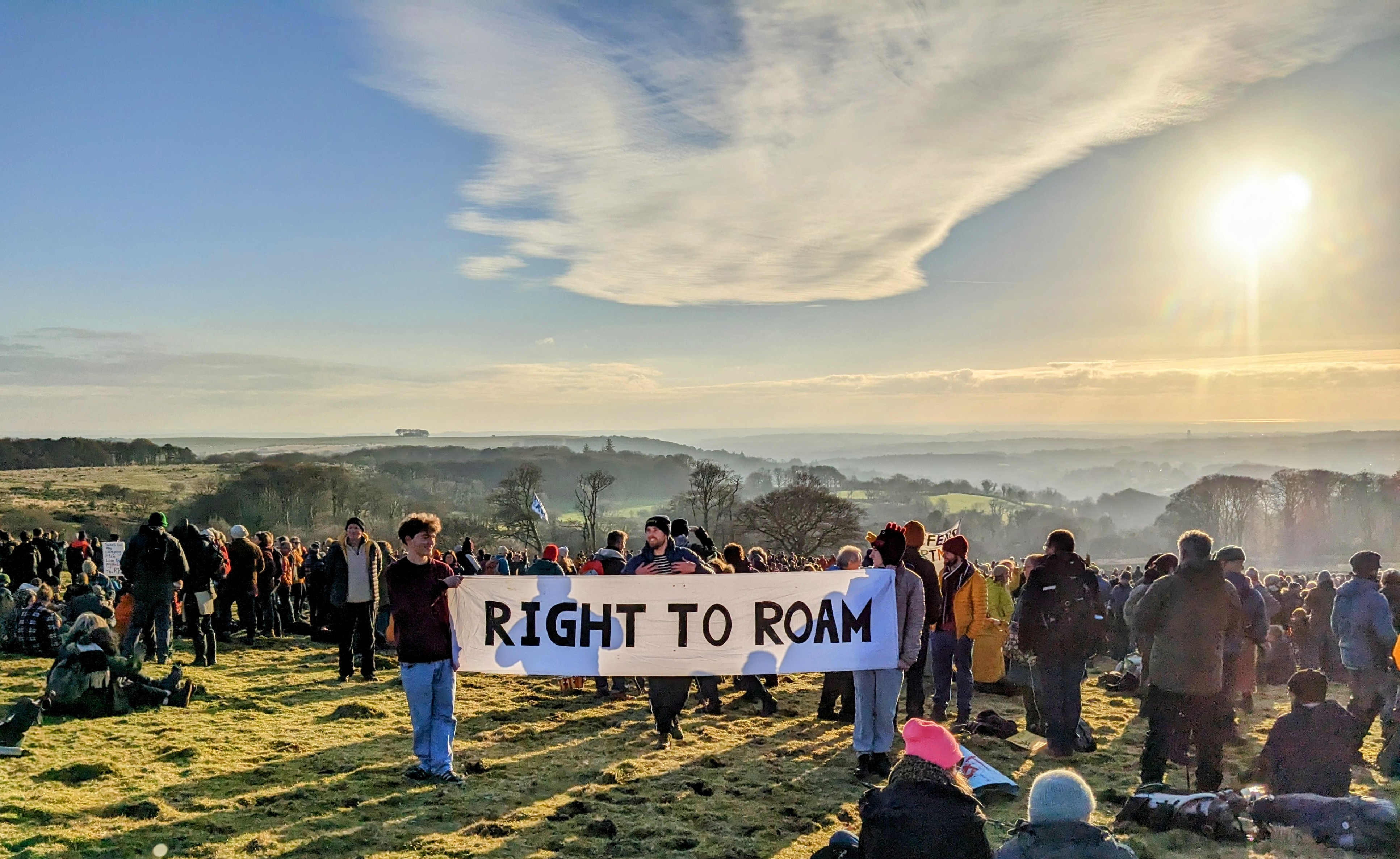Rewilding without considering humans isn't rewilding
We need to accept that humans are part of the rewilding process - and that we won't always tread carefully and "leave no trace". We are all part of the habitat.
Just around the corner from where I live in the suburbs of Bradford, West Yorkshire, there’s a grass verge that borders the pavement beside the A657 motorway. It’s overhung by cherry trees and backs on to a row of rusted lock-ups. It runs for about a hundred and fifty yards, from the back of a mini-mart (formerly Bargain Booze) to a junction with a side-road and a phone and computer repair shop.
It’s completely untended. It’s mid-August now and on my stroll past it this morning I clocked ragwort, St John’s wort, rosebay willowherb, two kinds of bumblebee, four kinds of ladybird, hazel and sycamore saplings, dandelions, nipplewort, three shield bugs, feral buddleia, blackberry bramble, a field grasshopper, a garden snail, thrift, mugwort, goosegrass and toadflax. I also recorded two large dogshits, three AA batteries, a beer can, a number of fag ends, a bit of old carpet, and a 35cl vodka bottle.
This is a rewilded landscape.
It became a joke, during the long, slow climb out of COVID lockdown, to riff on the ‘nature is healing’ cliché that by then was ubiquitous on social media. To reverent images of deer roaming deserted city streets or wildflowers sprouting through concrete, users added snaps of a dildo abandoned among the roots of a tree, shopping trolleys lounging companionably in a canal, a bag of garbage in a hedge. Nature is healing.
There’s more truth to it than you might think. Our ideas about non-human life are incomplete if they don’t come to an accommodation with the facts of human adjacency, the reality that humans will not always tread carefully, talk in hushed voices, leave no trace behind.
It’s not wild if it has a fence around it, and if it doesn’t have a fence around it – well, it might very well wind up being home to some dogshit, a vodka bottle and a bit of old carpet.
It’s important to see that urban and suburban nature is not ‘out of place’; it’s not an anomaly, not somehow unnatural or improper. The buddleia in the derelict gutter, the groundsel sprouting in the pavement cracks, these are just wild things doing what wild things do, living, growing, often thriving, whether we like it or not. If they can live there, they belong there. These places are habitats. Everywhere is a habitat.
When we consider a habitat – the unkempt edge of the A657, for instance – we have to think of it in its entirety, as a complete whole. It’s not the plants, the soil, the air and the insects, plus a bunch of extraneous stuff, stuff that’s neither here nor there, stuff that doesn’t count. It all counts. As well as the soil (compacted, poor) and air (hazy with traffic fumes), and as well as the interrelations of plants and creatures, we have to factor in the dogshit, the fag ends, the vodka bottle, the fly-tipped carpet. In short, we have to factor in us. We’re all part of the habitat. We might wish we weren’t – but then, if we weren’t, we’d be talking about a different habitat altogether.
I’ve heard people talk about ‘rewilding’ their gardens, letting them run amok, unmown, unweeded, vibrant with wildflowers and pollinating insects, and I think it’s a wonderful thing – but there’s an important reason why these gardens can’t really be said to be rewilded. It’s because they’re gardens; by their nature they are private, gated, owned. They may be full of wild flowers, wild insects, wild birds, but they’re missing a critical ingredient: people, by which I mean not the gardener or the rewilder but people, as a phenomenon, as an unpredictable feature of a dynamic habitat. It’s not wild if it has a fence around it, and if it doesn’t have a fence around it – well, it might very well wind up being home to some dogshit, a vodka bottle and a bit of old carpet.
That might not happen to a garden with a mown lawn and flowerbeds, a patio and a birdbath. These things signify stewardship; in a code with which we’re all familiar, they express the fact that someone cares about this place. They remove ‘ambiguity of ownership’. Studies of how people feel about their local green spaces identify this kind of ambiguity as a factor in making people feel unsafe or unwelcome. The presence of a park keeper or a gardener is again a signal that is not a wasteland, not a wilderness.
And of course we can turn this around and see that ambiguity of ownership is at the same time, in some ways, a liberation. If this belongs to nobody, then nobody’s in charge. We can transgress here! We needn’t conform to social norms: we can drop litter and fly-tip, we needn’t clean up after our dogs. What makes some people feel unsafe makes others feel emboldened, or empowered. I don’t say that this is a good thing. What I do say is that it’s the reality of wild places within the human purview, the human pale.
Back to the unkempt verge. This is a little wilderness. I call it that because although it could hardly be in a more built-up area, and although the resident wildlife is pretty pedestrian (we have yet to reintroduce lynx to the A657), this place has all the power here. For me, that’s what a wilderness is: a space defined not by its geography or ecology but by its relation to us, its place in the power dynamic.
A strong anti-people streak is evident not only in old-school get-orf-my-land types, but also among the carefully curated hills and vales of the rewilders.
Some wildernesses earn this power through their inaccessibility or physical hostility: Yellowstone, say, or the high Cairngorms. We simply can’t go there. We can’t do anything there. Other places have the upper hand over us because they are too difficult or too expensive or too toxic to exploit: industrial ruins, rotting urban infrastructure, that kind of thing. The neglected verge has a slightly different sort of authority. It exists because nobody gives a fuck about it.
Perhaps the local authority has decided it’s not worth expending resources on, or perhaps it’s a question of the council work team’s overloaded rota or low staffing levels. The verge is nobody’s priority. We can’t, therefore, easily get shot of it; it sticks around. It has the improbable power of the non-place. The power of the wilderness.
Widen the focus, pull away from the shield bugs and grasshoppers and booze debris of this Shipley edgeland. If we look with a broader perspective at the ‘wild’ places of the UK we can see that many of the same dynamics apply.
Wild land – whether it’s been ‘rewilded’, scrupulously set aside and left alone, or it’s rewilded itself or always been that way – has to be open if it’s to be considered wild; a wilderness with a fence is just a garden, or perhaps a zoo (and I say this as a fan of both gardens and zoos). Being open means being vulnerable. It means establishing a relationship with people, with human communities, because – for the time being at least – we’re not going anywhere. Landscapes can cope with this. This is something landscapes, living landscapes, can do. Whether landowners and land managers will let them do it is another question.
A strong anti-people streak is evident not only in old-school get-orf-my-land types, but also among the carefully curated hills and vales of the rewilders - a queasy tension, in the latter case, between ‘look at these splendid landscapes!’ and ‘stay they hell away from these splendid landscapes!’. Accommodations, though, must be made at some point. We can’t theorise people out of the ecological equation. The current hot-tempered debate over the right to roam may eventually clarify things a little.
But if we must get used, on the one hand, to thinking of people – with their trampling feet and bad habits, with all their thoughtlessness and unpredictability – as functional components of our ecosystems, then perhaps, on the other, we should take the trouble to rethink what we mean by ‘derelict’, by ‘disused’, by ‘wasteland’.
Perhaps we can observe codes other than those of formal ownership. Perhaps occupation by bugs and snails and thrift and goosegrass should count for something. My shitty grass verge is very obviously not disused – all kinds of things are using it. It isn’t derelict, as it hasn’t been relinquished, by the plants, by the insects, or by, shifting up an ecological tier, the blackbirds, robins, hedgehogs, mice, bats, and they have no obvious intention of giving it up any time soon. And it isn’t waste. Wild things let very little go to waste. That’s a human talent.
Owned and not owned, used and disused, somebody’s and nobody’s - these are not helpful binaries in a world where, as we struggle to salvage what we can from our declining ecosphere, compromise will be key. We can and must make room - in our lives, as citizens, as neighbours, but also in our ways of thinking, our philosophies of the ‘wild’ - for the neither-here-nor-there places, as they make room for us. Like them, we are resilient and adaptable. Like them, we can always find new ways to live, and grow, and thrive.
The Lead is now on Substack.
Become a Member, and get our most groundbreaking content first. Become a Founder, and join the newsroom’s internal conversation - meet the writers, the editors and more.





